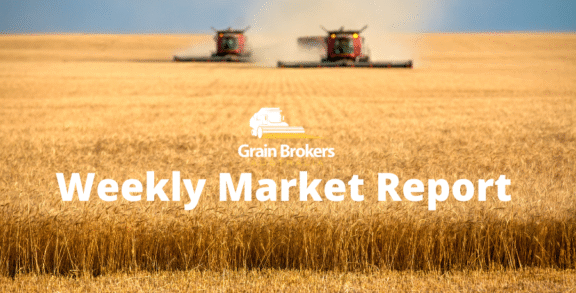
Widespread drought across the Prairies this year has seen Canadian grain, pulse and oilseed production fall year-on-year, and the nation’s agricultural commodity exports are forecast to suffer the same fate in 2023/24 on the back of the lower exportable surplus according to the October outlook for principal field crops from Statistics Canada.
With the winter/spring crop harvest done and dusted and the summer crop harvest drawing to a close, Canada’s principal field crop production is estimated to have decreased by 13 per cent from 97.1 million metric tonne in 2022/23 to 84.5MMT this season. Abandonment of parched crops saw a one per cent increase in the planted area compared to the previous season eroded by the time headers started to roll this year, resulting in an unchanged harvested area of 30.5 million hectares. The average yield across all crop types fell from 3.19 metric tonne per hectare to 2.77MT/ha.
Total wheat production is estimated at 29.8MMT, down from the third biggest crop on record of 34.3MMT last season, but still significantly higher than the 2021/22 drought crop of 22.4MMT. The harvested area of 10.7 million hectares was 5.6 per cent higher than last year, but the average yield, including durum wheat, came in at 2.8MT/ha. This was much lower than the 2022 harvest average of 3.41MT/ha, but notably higher than the 2021 average of 2.44MT/ha. Preliminary harvest results had more than 70 per cent of the crop (excluding durum) graded No.1 with an average protein of 14.2 per cent, and a further 25 per cent of the crop graded No. 2 with an average protein of 13.1 per cent.
This season’s barley crop came in at 7.8MMT, 21.5 per cent lower than the 10MMT reaped in 2022/23. This is 16 per cent below the average of the previous five seasons but is still 12.3 per cent higher than the 2021/22 disaster. The harvested area was fractionally higher year-on-year at 2.66 million hectares but the average yield of 2.95MT/ha was 22.2 per cent lower than the 3.79MT/ha average recorded last year. Despite a higher carry-in year-on-year, total supply has fallen to just 8.75MMT, the second smallest only to the record low of 7.9MMT set in 2021/22.
Canola production held up relatively well, with this year’s crop of 17.4MMT, only 1.3MMT lower than that of 2022/23 but still 7 per cent below the five-year average of 18.6MMT. The harvested area of 8.84 million hectares was 250,000 hectares higher than last year, but the average yield for this year’s harvest is the lowest in ten years at 1.96MT/ha, compared to 2.17MT/ha in 2022. The Canadian Grain Commission’s harvest survey program put the average oil content at 42.8 per cent, with 98 per cent of the crop categorised as the highest grade.
Canada is traditionally a big producer of oats, but this season’s crop of 2.4MMT was 53.4 per cent lower than the 5.2MMT harvested last season. It all started at seeding, with the planted area down by 570,000 hectares compared to the previous season. That seasonal difference carried through to the harvested area of just 0.83 million hectares. A much lower yield of 2.94MT/ha compared to 3.73MT/ha a year earlier completed the dismal production picture.
Row crop production has surprised to the upside with warm temperatures and good soil moisture conditions in the eastern provinces supporting average to above-average yields. Corn production increased from 14.5MMT to 14.9MMT due to a 4.1 per cent increase in the harvested area to 1.5 million hectares. The average yield of 9.93MT/ha is slightly lower than last year’s average of 10.07MT/ha. Soybean production is pegged 0.2MMT higher season-on-season at 6.7MMT, marginally higher than the five-year average of 6.5MMT. Like corn, the harvested area is up, and the average yield is down, showing 2.28 million hectares and 2.95MT/ha, respectively.
The main pulse crops in Canada are dry peas and lentils, with production this season each falling 33 per cent to 2.27MMT and 1.54MMT, respectively. The lower output is a function of a lower harvested area and a sharp fall in yields due to the drought across western Canada.
On the trade side of the equation, Statistics Canada is calling total 2023/24 season exports of all principal field crops 45.5MMT, 14 per cent lower than the 53.09MMT export program in 2022/23. Early season wheat exports have been quite brisk, with 5.1MMT shipped in the first 13 weeks of the Canadian marketing year (August to July), 11 per cent ahead of the same period in the 2022/23 season. The Canadian export program typically peaks in October each year before slowing down through the winter months.
Total wheat exports are forecast at 21.3MMT, down from 25.66MMT last season but significantly higher than the 15.07MMT shipped in the 2021/22 season. The USDA left Canadian wheat exports unchanged at 23MMT in its November global supply and demand update, but it also has production higher at 31MMT to balance the numbers. A private export forecast from Mercantile Consulting Venture in Winnipeg puts exports much lower at 18.5MMT.
Statistics Canada is pegging 2023/24 barley exports 8.75MMT, 1.8MMT lower season-on-season, with carry-out stocks falling to an extremely tight 0.55MMT. Oat exports are pegged at 2.45MMT, only slightly lower than the 2.67MMT of sales in 2022/23, reducing the carry-out to a perilously low 0.35MMT. Canola shipments to international clients are forecast at 7.7MMT, down marginally from 7.95MMT in the 2022/23 marketing year.
Corn exports are projected at 1.85MMT, slightly lower than last season, as domestic intake recovers. On the other hand, the soybean export forecast is 13.7 per cent higher at 4.8MMT, with domestic use slightly lower. Dry pea and lentil trade are likely to be 26 per cent and 36 per cent lower than last season at 1.9MMT and 1.4MMT, respectively.
Meanwhile, the Prairies, Canada’s most crucial crop-growing region, have become hotter and drier over the last 120 years, according to research released by the University of Alberta last week. The review, which looked at climate data for the cropland provinces of Alberta, Saskatchewan and Manitoba from 1901 to 2021, revealed a consistent trend of higher air temperatures in winter and spring, less snowfall and more disruptive weather events.
The milder winters will likely result in lower snow levels throughout the winter and periods of mid-season snow melt, leaving the exposed crop more susceptible to climate extremes. This will, in turn, lead to less soil moisture in the early spring months, which is critical for sustaining post-dormancy crop growth.
The warmer growing conditions will also increase soil moisture evaporation rates, meaning more spring and summer rainfall will be required to sustain crop growth, health, and, ultimately, grain production. While the warmer climate could allow for a northward expansion of the current Canadian cropping area, the report concluded that any output gains will likely be outweighed by lower and less consistent production in the lower latitudes.
Call your local Grain Brokers Australia representative on 1300 946 544 to discuss your grain marketing needs.





